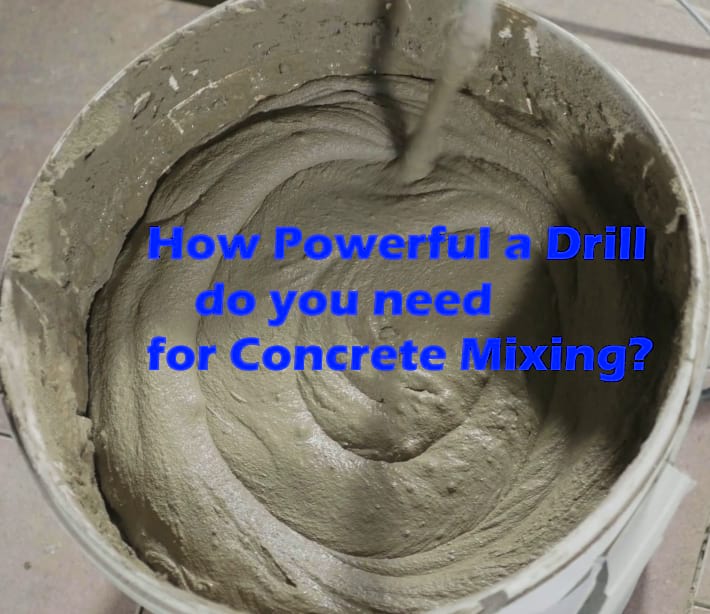DIYers and professionals use concrete when handling various tasks. The secret for the best mix is to get the right concrete drill mixer attachment, and the drill will do the rest. The final blend is a smooth combination of cement and water, producing one of the strongest construction materials.
The fatigue that comes with mixing concrete manually will soon have you looking to acquire a concrete mixing tool. If you get a good drill with a good mixer attachment it will stir your mixture with ease.
The exact power of a drill you need for controlling your concrete mixer depends on many features. Before we get into the details, we need to understand the definition of a mixer drill.
What is a mixer drill?
A mixer drill is a type of drill with paddled attachments or blades that help in the mixing of concrete. The shape of the paddle or blades depends on the components that make up your concrete. The design of a mixer drill ensures the best mixing of your content. The power and speed of a mixer drill depend on different characteristics. The article will look at these important factors to pin down a drill with enough power to perfrom concrete mixing.
Dedicated mixer drills are not the standard drills with 10mm or 13mm chucks that drill holes and drive screws, although if you have a cordless drill from the same manufacturer then you might be able to buy just a mixer drill 'skin' and reuse the same battery pack.
Should you get a dedicated mixer drill? / What power do you need?
Many tradies continue to struggle with a standard power drill for complex mixing jobs instead of using a special hand-held mixer drill.
A standard drill can certainly be adequate for mixing small volumes of low viscosity liquid materials at a low rpm, for example mixing paint needs little effort compared to mixing concrete and you would do fine buying mixer attachments for a standard drill.
Concrete is another matter.
When materials with high viscosity or large mixing volumes have to be mixed then a normal drill should not be your first choice. Because a standard power drill is designed to drill in short bursts and not mix for long periods of time, they tend to quickly overheat and burnout. In addition to either having to stop and start (increasing the mixing time) or potentially breaking your power drill, you will also find it puts a higher physical strain on you.
Compared with ordinary drills, dedicated mixers drills are specially designed for heavier sustained loads that mixing causes. The drive elements supply more power and crucially more torque, they also have greater cooling for the motor so that under the heavy load they don't overheat, finally they are specifically geared to ensure a long life and optimum performance.
The thickness of the concrete and its area of application determine the resistance to the mixer. A thick concrete mix demands more power from the drill.
It would be best if you had some power rate, which depends on your line of work and where the material is to be poured. To calculate the exact power, you must know the torque. .
Power ratings
You can find drills that can range from 800 to 8,000 watts. You may need more power if working in an industrial setting. Ideally, if you want enough power to spare for other projects, look for a powerful drill capable of producing a minimum of 1,300 watts.
Other factors to consider
The Capacity to Mix
Consider at how many kilos of concrete you can mix at once. Many products will give a guide to this and the number of kilos of concreate is an guide to the maximum weight of any material you can handle without any risk of overloading the mixer, despite being designed for these jobs the cheaper ones can still be prone to overheating, risking the motor.
Speed of Rotation
The speed of rotation of a concrete mixer drill relies on the motor speed in terms of revolutions per minute and motor rotational speed. A high-end model mixer can give more than 700 rotations per minute, but if you can get one that goes for 500 rotations per minute, it can suit.
The demand for more rotational speeds is suitable for an electric gear that can increase or reduce the motor rotation. Slow speeds work well for mixing thick materials like masonry, while the fast speed is ideal for mixing lightweight concrete for light jobs.
Buying tip: A mixer with gears manipulating the motor rotation is a better choice because it does not produce splatter spreading the mixture all over. It also gives you an opportunity of maintaining control over the quality of the mix.
A powerful drill for concrete mixing requires that you have an attachment that makes its rotation effective. Here is something about the blade components
Spindles
A mixer attachment can have either a single or a double spindle. The double one works will make the mixing within a short time.
Blades and Paddles
Blades with paddles make mixing thick concrete manageable. All you have to do is check if the blades and paddle attachments fit with your drill.
Attachments can mix in any direction or up and down. The mixing style depends on your preference. When buying the attachments, you need to be sure about the drill’s chuck diameter allowance to avoid the disappointment of buying something you cannot use.
Finally
It is only one thing to consider the power ratings of a concrete mixer drill, you will also want to look at its others features. You should also factor in the weight of the concrete mix and its application environment.







